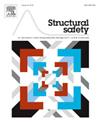LSTM-augmented probability-informed neural network-driven evolution estimation for time-dependent reliability analysis
IF 6.3
1区 工程技术
Q1 ENGINEERING, CIVIL
引用次数: 0
Abstract
For time-dependent dynamic systems, the inputs include not only random variables but also stochastic processes, posing significant challenges to traditional Time-Dependent Reliability Analysis (TDRA) methods regarding efficiency, accuracy, and generality. To address these challenges, this paper develops a Long Short-Term Memory (LSTM)-Augmented Probability-Informed Neural Network Evolution (LPNE) framework for TDRA of dynamic systems. A set of local performance functions is introduced by selecting representative points for time-independent random variables. Subsequently, an LSTM network is trained to learn the time-dependent behavior of the dynamic system for each local limit state function. Multiple local surrogate LSTM models are then employed to assemble an enhanced dataset accordingly. Based on the enriched dataset, point-evolution estimation is performed with a more ample sample size, integrating Deep Neural Networks (DNN) with the physical equation information of the generalized probability density evolution equation (GDEE). The proposed framework can effectively compensate for the limitations of existing point-evolution approaches that struggle to consider scenarios with stochastic process inputs. The proposed LPNE is validated through four benchmark cases: a simple numerical example, scenarios involving corroded steel beams, corrosion-induced deterioration of steel structures, and the seismic response of multi-story shear frame structure. The results demonstrate that LPNE can accurately and efficiently estimate time-dependent failure probabilities with a limited number of representative points without requiring additional samples.
时变可靠性分析的lstm增强概率神经网络驱动进化估计
对于时变动态系统,输入不仅包括随机变量,还包括随机过程,这对传统的时变可靠性分析方法在效率、准确性和通用性方面提出了重大挑战。为了解决这些挑战,本文开发了一个用于动态系统TDRA的长短期记忆(LSTM)-增强概率-通知神经网络进化(LPNE)框架。通过选取时间无关随机变量的代表点,引入一组局部性能函数。然后,训练LSTM网络学习动态系统的每个局部极限状态函数的时变行为。然后使用多个本地代理LSTM模型相应地组装增强的数据集。在此基础上,将深度神经网络(DNN)与广义概率密度进化方程(GDEE)的物理方程信息相结合,以更大的样本量进行点进化估计。所提出的框架可以有效地弥补现有的点进化方法的局限性,这些方法难以考虑具有随机过程输入的场景。提出的LPNE通过四个基准案例进行验证:一个简单的数值例子,涉及腐蚀钢梁的场景,钢结构腐蚀引起的劣化,以及多层剪力框架结构的地震反应。结果表明,LPNE可以在不需要额外样本的情况下,以有限的代表性点准确有效地估计随时间变化的失效概率。
本文章由计算机程序翻译,如有差异,请以英文原文为准。
求助全文
约1分钟内获得全文
求助全文
来源期刊

Structural Safety
工程技术-工程:土木
CiteScore
11.30
自引率
8.60%
发文量
67
审稿时长
53 days
期刊介绍:
Structural Safety is an international journal devoted to integrated risk assessment for a wide range of constructed facilities such as buildings, bridges, earth structures, offshore facilities, dams, lifelines and nuclear structural systems. Its purpose is to foster communication about risk and reliability among technical disciplines involved in design and construction, and to enhance the use of risk management in the constructed environment
 求助内容:
求助内容: 应助结果提醒方式:
应助结果提醒方式:


